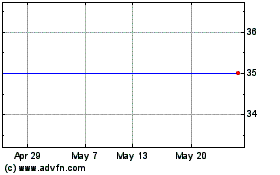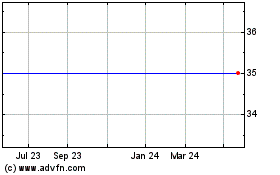The U.K. government Monday threw its weight behind sweeping new
reforms for the banking sector that will involve requiring banks to
segregate, or "ring-fence," their retail activities from riskier
investment banking activities to better protect depositors.
In a widely expected endorsement of the Independent Commission
on Banking report, Chancellor of the Exchequer George Osborne told
lawmakers that there will be a final legislative package, mostly
having to do with capital requirements, but that he will move
faster and separately to bring in ring-fencing as a priority.
Meanwhile, Osborne said the government, as an 83%-holder in
Royal Bank of Scotland PLC (RBS), would push for the bank to be
completely restructured as a retail bank for its corporate and
individual clients. While the investment bank would support this
business, it would no longer be the bank's focus.
Osborne said that the U.K. taxpayer had paid some GBP45.5
billion into RBS in the wake of the financial crisis. At the
current price, that investment has fallen in value by GBP27
billion, he added.
Still, a key focus of his statement was the controversial
ring-fencing of U.K. banks.
"I can confirm to the House today that primary and secondary
legislation related to the ring fence will be completed by the end
of this Parliament in May 2015, and banks will be expected to
comply as soon as practically possible thereafter," Osborne
said.
The ring-fenced bank will be legally and operationally
independent and comprise the deposits and overdrafts of individuals
and small and midsize businesses.
"Our objective is clear. We want to separate high-street banking
from investment banking to protect the British economy, protect
British taxpayers and make sure the nothing is too big to fail.
Second, we will make sure that banks have bigger cushions, so they
are better able to withstand losses," Osborne said.
However, the government pulled back from the ICB's
recommendations that the country's largest banks should hold as
much as 20% in equity and loss-absorbing debt against their
assets.
Large ring-fenced retail banks will be required to hold equity
capital of at least 10%. There will also be a minimum requirement
for the loss-absorbing capacity of the big banks of at least
17%.
This will apply to the U.K. operations of British banks. It will
also be applied to the non-U.K. operations of U.K.-headquartered
banks, except where they can demonstrate they do not pose a threat
to the U.K. taxpayer, he added.
John Longworth, director general of the British Chambers of
Commerce, said the "unilaterally high capital ratios proposed by
the report could weaken growth over the medium-term. We should not
damage an industry with good growth prospects where the U.K. has a
comparative advantage."
Meanwhile, implementation for the outstanding proposals would
proceed in stages with the final changes related to loss absorbency
fully completed by the beginning of 2019, in line with the Basel
agreement.
Osborne said reforms were designed to protect taxpayers from the
cost of failing banks, while at the same time acknowledging the
importance of the financial sector to the country.
"Britain should remain home to one of the world's leading
financial centres and the home of global banks. But the strength of
this industry is also a potential weakness to the economy if not
properly regulated," he said.
Osborne said the government estimates total costs to U.K. banks
to be GBP3.5 billion to GBP8 billion, compared with the ICB's
estimate of GBP4 billion to GBP7 billion.
U.K. banking shares move lower after Osborne's statement. RBS,
Lloyds Banking Group PLC (LYG) and Barclays PLC (BCS) closed down
3%-4% in a mostly lower day for European financial shares.
RBS responded to Osborne's comments, saying it was already
committed to shrinking its investment bank and that it would
provide a final update early next year.
"We confirmed last month that we would adjust the size of our
investment bank in line with changing market conditions. We will
update on final decisions in the New Year following consultation
with our major shareholders," the bank said.
The bank--which more than halved its Global Banking and Markets
investment-banking-arm balance sheet to GBP399 billion from GBP874
billion at the end of 2007--is looking to cut it further to GBP200
billion, a person familiar with the situation said Monday.
In addition, RBS is considering selling Hoare Govett, its
brokerage business and could make other disposals from the
investment banking business.
Barclays is likely to be hit hardest by the ring-fencing because
it derives some 50% of group profit before tax from investment
banking. For example, the bank reported adjusted profit of GBP2.8
billion for its corporate and investment banking business for the
nine months to Sept. 30, compared with GBP2.6 billion from its
retail and business banking.
A Barclays representative declined to comment following
Osborne's statement, but just days ago, CEO Bob Diamond said the
impact of the new regulations would primarily be felt on Barclays
Capital.
Lloyds will be less affected by the ring-fencing reforms because
some 95% of its operations fall inside the protected activity. The
remaining 5% of riskier activities comprise derivative platform and
hedging activities but, unlike RBS and Barclays, these are only
done on behalf of clients and Lloyds doesn't have a proprietary
trading desk.
"We welcome the greater clarity provided by HMT's response to
the ICB final report and look forward to working with HMT in the
coming months ahead of the final white paper in 2012 as further
detail is needed on some of the issues discussed today," Lloyds
said.
The modification of the so-called Primary Loss Absorbing
Capacity--with the requirement down to 17% from a 17%-to-20%
range--is likely down to stiff opposition from the banking lobby,
according to analysts, and in particular the risk of HSBC Holdings
PLC (HBC) deciding to re-domicile rather than having to meet the
new requirements.
A representative for HSBC declined to comment on what effect the
watering-down of the capital requirements might have on the bank's
plans.
However, last month the bank, which generates the bulk of its
earnings outside of the U.K., particularly in Asia, said it would
delay a decision on where to base its headquarters for a year to
give it more time to consider the costs and effects of the new
regulatory reforms.
"We welcome the further clarity provided by the government this
afternoon. A great deal of detailed work is still required before
the principles can be put into practice and we will continue to
work constructively with the government in the months ahead,"
Douglas Flint, HSBC chairman, said later Monday.
"As the legislation becomes clear we will take the necessary
measures to enable HSBC to continue to provide sustainable credit
to our customers and acceptable returns to shareholders," he
added.
The proposals are unlikely to have much impact on U.K.-based,
Asia-focused Standard Chartered PLC (STAN.LN) because it has no
U.K. retail operations and wouldn't be affected by a retail ring
fence, but its CEO last week said that it would be hard to strike a
balance between protecting taxpayers and customers and stimulating
the U.K. economy.
Experts said that the inclusion of overseas operations in the
17% requirement loss-absorbing capacity for big banks may work
against U.K. desires to remain attractive as a financial
center.
"The main surprise is the requirement of at least 17%
loss-absorbing capacity for big banks-- including their overseas
operations. This will make the U.K. particularly unattractive for
those UK banks whose operations are mostly outside the U.K.," said
Michael McKee, U.K. head of Financial Services Regulatory at law
firm DLA Piper.
The third pillar of the ICB's recommendations relates to
competition in the U.K.
Monday, Osborne said he supported ICB recommendations that would
enable customers to switch banks easily and without cost and that
the Lloyds disposal met the ICB's criteria.
-By Marietta Cauchi, Dow Jones Newswires; +44 207 842 9241;
marietta.cauchi@dowjones.com
(Nicholas Winning contributed to this article.)
Nbnk Invest (LSE:NBNK)
Historical Stock Chart
From Jan 2025 to Feb 2025

Nbnk Invest (LSE:NBNK)
Historical Stock Chart
From Feb 2024 to Feb 2025
